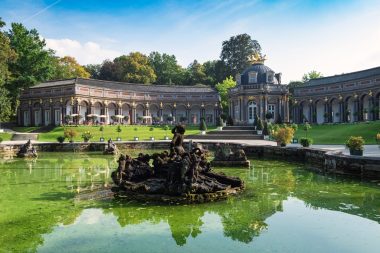The Bavarian city of Bayreuth in Upper Franconia near Nuremberg is located between the Fichtel Mountains and Franconian Switzerland and is crossed by the red Main. Today, almost 75,000 inhabitants find their home in the historic picture-book city. The city officially consists of 74 districts on about 66km². The remarkable city center is the historic center of Bayreuth and should not be confused with the “Altstadt” district under any circumstances.
Bayreuth was founded as early as the 12th century by the Andechs-Meranians. In 1457, the city coat of arms was awarded by Markgrad Albrecht Achilles of Brandenburg . After a movingly long city history between the 12th century and the 19th century, Bayreuth initially remained largely unscathed during the last World War. In the course of the war, however, some of the city centre was destroyed. The internationally renowned Festspielhaus was spared.
Sights in Bayreuth
Richard Wagner Festival

Many people probably know Bayreuth mainly from the famous annual Richard Wagner Festival . This is a festival for musical theatre dedicated to Richard Wagner (1813-1883). The concerts take place on the Green Hill, a hill in Bayreuth, in the Festspielhaus, which was built especially for the concerts. Normally, the festival is performed from July 25 to July 28. The associated Richard Wagner Museum presents the life and works of Richard Wagner in a permanent exhibition. In changing special exhibitions, a wide range of topics are presented. The National Archives of the Richard Wagner Foundation contain the largest collection of letters, manuscripts and musical notation in the world. Due to the Corona pandemic, a replacement program will take place in 2020.
Margravial Opera House
The Margravial Opera House, which is a UNESCO World Heritage Site, is one of the best-preserved Baroque court theatres in the world. It was built from 1744 to 1748 and was last extensively restored in 2018. In the historic halls, concerts of classical music are mainly played. Due to the unique acoustics and the historic ambience, the events in the margravial opera house in Bayreuth are still well attended today.
Zwernitz Castle

Not far outside the city of Bayreuth lies Zwernitz Castle. It was built in 1156 and was initially used as the ancestral seat of the Walpoten. Later, around 1300, the castle became the official residence of the burgraves of Nuremberg and Kulmbach. Inside the castle there is exciting documentation about the castle’s history and its inhabitants. The premises are still used today for receptions and lectures.
Ecological Botanical Garden
The Ecological Botanical Garden in Bayreuth shows the diversity of the most diverse plant species. Here, systematically sorted by the origin of the plants, you will find many explanations and information about the different habitats. The University of Bayreuth is conducting extensive research on the preservation of endangered animal and plant species. Regular guided tours are offered for visitors. In addition, other events in the sense of concerts or exhibitions take place alternately.
Bayreuth Catacombs
The Bayreuth Catacombs offer an exciting atmosphere in the sandstone grated corridors. Here you can learn exciting facts about the historical history of the brewery and its customs. Between the 15th and 19th centuries, the tunnels were built underground. At first, ore was mined deeper and deeper. Later, the resulting corridors were used for storage. During the war, the complex served as a shelter and at times even as a kitchen, military hospital and even a prison. Informative guided tours and visits are possible at any time by arrangement.
Old Hermitage Palace

A little bit outside the city of Bayreuth is the Hermitage Palace, built in 1715 by Margrave Georg Wilhelm. It was a gift to his wife Wilhelmine, who liked to deal with expanding renovation measures. Thus, an imposing court garden was created on the site and gradually an additional new palace. The construction of the new castle began in 1749 and was completed in 1753. The entire complex impresses with baroque elements and impressive garden architecture. Parts of the new castle are now used for concerts, exhibitions and readings.


